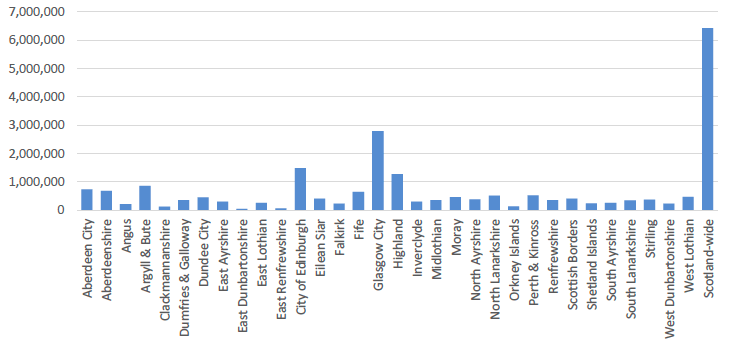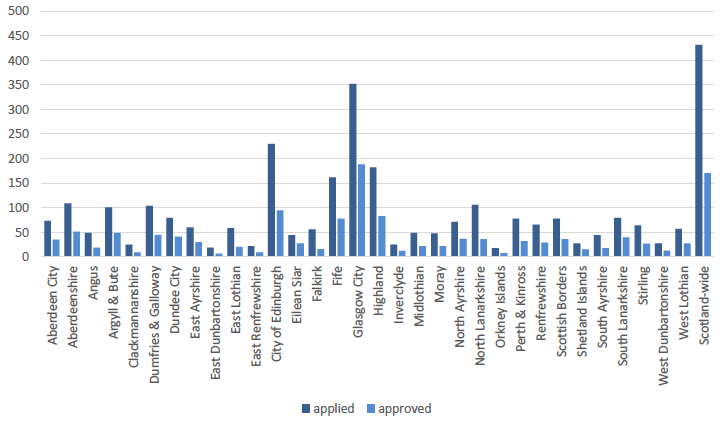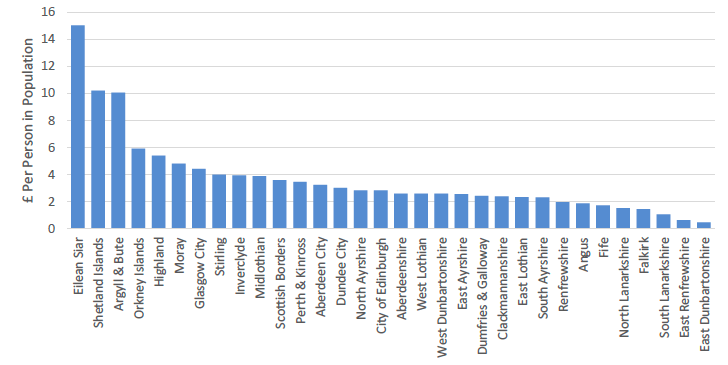Third Sector Resilience Fund (TSRF): analysis of applications and wards
Analysis of the data on applications to the Third Sector Resilience Fund (TSRF) and the awards made through the fund.
4. Funding by Geographical Location
Data was collected on the location of the applicant organisations (see Appendix 1 for a summary data table). In most cases, applicants identified where their organisation predominantly operates (either a single local authority area or "Scotland-wide") during the application process. Where this information was not provided, the primary local authority has been assumed based on the postcode provided in the application form.
The local authority data is limited by the fact that some organisations operating across more than one local authority area will have specified their primary location, whereas others will have identified themselves as "Scotland-wide". It is also likely that there is some degree of error in the prediction of local authority areas based on postcodes. This data discussed below should therefore be seen as a useful indication of the distribution of funding across local authority areas, but should not be taken to be exact. It is also important to note that the aim of the TSRF was to assist any eligible TSO in need of financial support to continue operating, regardless of their location. It was not, therefore, expected that the funds would necessarily be evenly distributed across local authority areas.
Figure 5 shows the total amount of funding received by organisations based in each local authority area. It shows that the largest share of funding (28 per cent) went to Scotland-wide organisations (£6,418,746). Scotland-wide organisations also accounted for the largest number of applications (431) and the second-largest number of awards (170) (see Appendix 1).
As the data in Appendix 1 shows, of the 32 local authority areas, organisations based in Glasgow City (12 per cent), City of Edinburgh (7 per cent), and Highland (6 per cent) received the largest share of funding. Glasgow, Edinburgh and Highland also accounted for the highest number of applications from all organisations which specified a particular local authority area (352, 230 and 182 applications respectively), and the highest number of awards (188, 95 and 83 respectively). This is unsurprising given that, according to 2018 data from the Scottish Council for Voluntary Organisations (SCVO), these three areas have the highest numbers of TSOs of all local authority areas in Scotland.[2]
TSOs based in East Dunbartonshire (0.2 per cent), East Renfrewshire (0.3 per cent), and Clackmannanshire (0.5 per cent) received the smallest share of grant funding. To a large extent this was because relatively few organisations based in these areas submitted applications to the fund (19, 22 and 25 respectively). This is in line with the fact that relatively few TSOs are based in these three local authority areas compared to the rest of the country.[3]
Grant Funding (£) Awarded by Local Authority Area

Number of Grant Applications and Awards by Local Authority Area

When weighted to account for the population size of each local authority, on average £3.65 was distributed to organisations based in each local authority area per person living in that area. As shown in the Figure 7, organisations in Na h-Eileanan Siar (£15.03), the Shetland Islands (£10.20) and Argyll and Bute (£10.07) received the highest amounts of funding by this measure. Organisations in East Dunbartonshire (£0.44), East Renfrewshire (£0.61) and South Lanarkshire (£1.05) received the lowest amount of funding per person living in the local authority area.
To a large extent, these figures reflect the differing numbers of voluntary organisations in comparison to the population size in each local authority area. For example, according to SCVO data from 2018, the number of charities per 1000 people was particularly high in the three areas where TSOs received the most funding per person living in the area: Na h-Eileanan Siar (10.4); the Shetland Islands (10.1); and Argyll and Bute (8.1). Meanwhile this ratio was relatively low in East Dunbartonshire (2.0), East Renfrewshire (2.5) and South Lanarkshire (1.7), the three local authority areas where TSOs received the least amount of funding per person living in the area.[4]
These average amounts should also be treated with caution because in some cases the data is skewed by the awarding of large grants to large organisations in areas with small populations. In the case of Na h-Eileanan Siar, for example, 28 organisations were awarded grants, with an average award size of £14,242 – lower than the overall average of £16,792 – but a single large organisation accounted for almost one quarter of the funding awarded to TSOs in this local authority area. Similar patterns are evident in the data for the Shetland Islands, Argyll and Bute, and the Orkney Islands.
Grant Funding Awarded (£) Per Person by Local Authority Area

The application approval rate varied significantly across local authorities, ranging from a 64 per cent approval rate for organisations based in Na h-Eileanan Siar to 29 per cent for organisations based in Falkirk. It is not clear why the application approval rate varied so widely across the country, but possible influencing factors include organisations in some areas being disproportionately affected by the pandemic and lockdown, organisations in some areas being more likely to meet the eligibility criteria, or the TSRF being more widely promoted in some areas than others.
Contact
Email: socialresearch@gov.scot
There is a problem
Thanks for your feedback